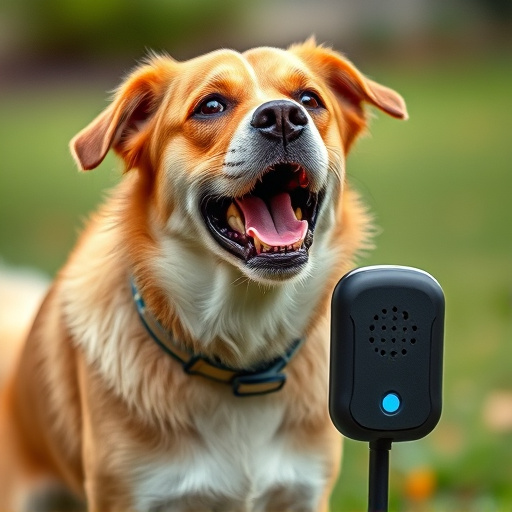This text compares handheld and wall-mounted ultrasonic repellents for pet training, emphasizing their unique pros and cons. Handheld devices offer portability for targeted use in problem areas of multi-level homes or small spaces, while wall-mounted options provide continuous protection across larger rooms or floors, blending discreetly into the environment. Both types use high-frequency sound waves to train pets without harm, but handheld models require manual operation and may be less suitable for smaller animals, whereas wall-mounted repellents have higher installation costs and reduced adjustability. The optimal choice depends on whether convenience (handheld) or consistent protection (wall-mounted) is prioritized based on home layout and specific pet training needs. Safety measures, including adhering to manufacturer guidelines and monitoring pet behavior, are crucial with both types.
Discover the revolutionary power of ultrasonic pet training safety devices, a non-violent approach to keeping pets in check. This article delves into the science behind ultrasonic repelents, exploring how high-frequency sound waves effectively guide—not harm—your furry friends. We dissect the classic handheld versus wall-mounted designs, weighing their pros and cons. Additionally, we tackle critical safety concerns, ensuring peace of mind while training your pets. Get ready to choose the perfect ultrasonic device tailored to your needs.
- Understanding Ultrasonic Repellents: How They Work and Their Benefits
- Handheld vs Wall Mounted: Pros and Cons of Each Design
- Safety Considerations: Are Ultrasonic Devices Harmful to Pets?
- Choosing the Right Ultrasonic Pet Training Device for Your Needs
Understanding Ultrasonic Repellents: How They Work and Their Benefits
Ultrasonic repellents are a popular choice for pet training and safety, utilizing sound waves to create an effective barrier against unwanted behaviors. These devices emit high-frequency sound at levels inaudible to humans but irritating to animals like dogs and cats. Unlike traditional, often harsher methods, ultrasonic repelants offer a humane alternative by encouraging positive behavior change without causing physical harm.
Handheld versus wall-mounted ultrasonic repellents represent two distinct approaches. Handheld devices provide portability, allowing users to move them around based on specific needs or problem areas. Wall-mounted options, on the other hand, offer constant protection and are ideal for addressing persistent issues in specific rooms or areas of your home. Both types have benefits, with selection depending on individual preferences and pet training goals.
Handheld vs Wall Mounted: Pros and Cons of Each Design
When it comes to ultrasonic pet training safety devices, one of the key decisions homeowners face is choosing between a handheld or wall-mounted design. Each option has its unique advantages and drawbacks, influencing the device’s effectiveness and user experience.
Handheld models offer portability and versatility. They’re ideal for multi-level homes, as users can easily carry them up and down stairs. Handheld devices also excel in small spaces, allowing for precise targeting of problematic areas. However, they may require more frequent manual operation, as opposed to wall-mounted units that maintain a constant presence. On the other hand, wall-mounted ultrasonic repellents provide a permanent solution by installing directly into your home’s infrastructure. They’re less obtrusive and can cover larger areas without needing to be carried around. Yet, their installation costs can be higher, and they might not be as easily adjustable for specific pet needs.
Safety Considerations: Are Ultrasonic Devices Harmful to Pets?
Ultrasonic pet training devices, both handheld and wall-mounted repellents, have gained popularity for their non-invasive approach to modifying animal behavior. However, safety considerations are paramount when introducing such technology into your home. The primary concern revolves around whether these devices are harmful to pets.
Handheld ultrasonic devices emit high-frequency sound waves that are inaudible to humans but can startle or deter animals. While they are generally considered safe for most pets when used correctly, the potential for distress or even physical harm exists, especially with smaller animals like birds and reptiles. Wall-mounted repellents, on the other hand, operate continuously, which could lead to prolonged exposure and heightened sensitivity over time. It’s crucial for pet owners to follow manufacturer guidelines, ensure proper placement away from sensitive areas like food bowls and beds, and monitor their pets’ behavior after using these devices.
Choosing the Right Ultrasonic Pet Training Device for Your Needs
When considering an ultrasonic pet training safety device, it’s crucial to match your choice with your specific needs and living space. Handheld devices are ideal for smaller areas or on-the-go use. They’re convenient for multi-pet households, allowing you to target each pet individually. However, their range is typically limited, making them more suitable for apartments or small homes.
In contrast, wall-mounted ultrasonic repellents are designed for larger spaces like houses with open layouts. These devices offer a broader range and can cover an entire room or floor. They’re also less obtrusive when installed on walls, blending into the environment. While they might require more setup time, they provide consistent protection for larger pets or situations where multiple animals need training simultaneously.
When it comes to training your pets, a Handheld Vs Wall Mounted Ultrasonic Repellent can be an effective tool. By understanding how these devices work, considering safety aspects, and selecting the right fit for your needs, you can ensure a positive training experience without causing harm to your furry friends. This innovative technology offers pet owners a humane and non-invasive method to guide their pets’ behavior, making it a worth considering option in today’s world.
